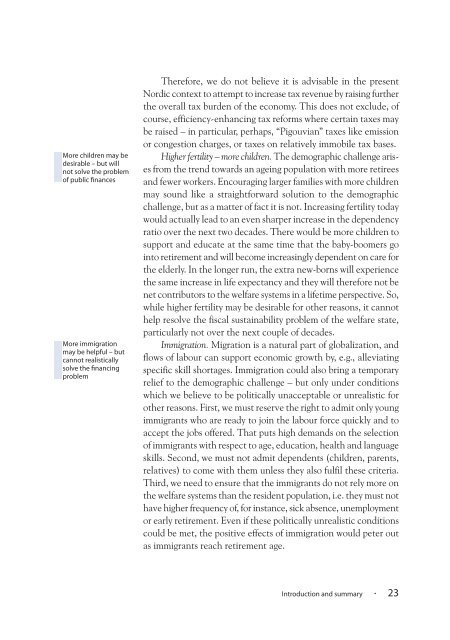The Nordic Model - Embracing globalization and sharing risks
The Nordic Model - Embracing globalization and sharing risks
The Nordic Model - Embracing globalization and sharing risks
You also want an ePaper? Increase the reach of your titles
YUMPU automatically turns print PDFs into web optimized ePapers that Google loves.
More children may be<br />
desirable – but will<br />
not solve the problem<br />
of public finances<br />
More immigration<br />
may be helpful – but<br />
cannot realistically<br />
solve the financing<br />
problem<br />
<strong>The</strong>refore, we do not believe it is advisable in the present<br />
<strong>Nordic</strong> context to attempt to increase tax revenue by raising further<br />
the overall tax burden of the economy. This does not exclude, of<br />
course, efficiency-enhancing tax reforms where certain taxes may<br />
be raised – in particular, perhaps, “Pigouvian” taxes like emission<br />
or congestion charges, or taxes on relatively immobile tax bases.<br />
Higher fertility – more children. <strong>The</strong> demographic challenge arises<br />
from the trend towards an ageing population with more retirees<br />
<strong>and</strong> fewer workers. Encouraging larger families with more children<br />
may sound like a straightforward solution to the demographic<br />
challenge, but as a matter of fact it is not. Increasing fertility today<br />
would actually lead to an even sharper increase in the dependency<br />
ratio over the next two decades. <strong>The</strong>re would be more children to<br />
support <strong>and</strong> educate at the same time that the baby-boomers go<br />
into retirement <strong>and</strong> will become increasingly dependent on care for<br />
the elderly. In the longer run, the extra new-borns will experience<br />
the same increase in life expectancy <strong>and</strong> they will therefore not be<br />
net contributors to the welfare systems in a lifetime perspective. So,<br />
while higher fertility may be desirable for other reasons, it cannot<br />
help resolve the fiscal sustainability problem of the welfare state,<br />
particularly not over the next couple of decades.<br />
Immigration. Migration is a natural part of <strong>globalization</strong>, <strong>and</strong><br />
flows of labour can support economic growth by, e.g., alleviating<br />
specific skill shortages. Immigration could also bring a temporary<br />
relief to the demographic challenge – but only under conditions<br />
which we believe to be politically unacceptable or unrealistic for<br />
other reasons. First, we must reserve the right to admit only young<br />
immigrants who are ready to join the labour force quickly <strong>and</strong> to<br />
accept the jobs offered. That puts high dem<strong>and</strong>s on the selection<br />
of immigrants with respect to age, education, health <strong>and</strong> language<br />
skills. Second, we must not admit dependents (children, parents,<br />
relatives) to come with them unless they also fulfil these criteria.<br />
Third, we need to ensure that the immigrants do not rely more on<br />
the welfare systems than the resident population, i.e. they must not<br />
have higher frequency of, for instance, sick absence, unemployment<br />
or early retirement. Even if these politically unrealistic conditions<br />
could be met, the positive effects of immigration would peter out<br />
as immigrants reach retirement age.<br />
Introduction <strong>and</strong> summary · 23

















